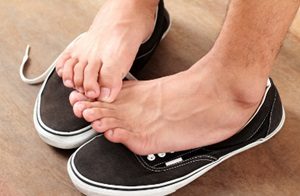
You may have heard of athlete’s foot and thought you weren’t at risk because, well, you’re not an athlete, but anyone can get it. Here are the causes of athlete’s foot, the signs and symptoms of athlete’s foot and the risk factors for athlete’s foot that you need to look out for to determine if you’re at risk.
What is athlete’s foot?
Athlete’s foot forms because there is a presence of fungus and bacteria. Although fungus and bacteria are present all over the skin, when the conditions become right for the bacteria or fungus to grow – usually in moist, warm places like in your shoes – that is when infection sets in. The fungus in athlete’s foot is called dermatophytes and it thrives on eating other organisms.
It is strongly advised you do not pick or touch the infection as it is highly contagious and can spread along your hands.
Symptoms of athlete’s foot
Because of its reddish color and dryness, athlete’s foot is often mistaken for eczema or simply dry skin. This is why it’s important to know the signs and symptoms of athlete’s foot. With a variety of signs and symptoms of athlete’s foot, here are some to look out for. Once again, these will generally occur in and between the toes:
- Itchiness
- Dryness
- Stinging
- Cracking and peeling of the skin
- Raw skin
- Discolored, thick and crumbly toenails
- Toenails that pull from the nail bed.
If you begin to notice any of these signs and symptoms of athlete’s foot, seek medical advice as treatment can be difficult. In particular, if you are diabetic or have a weakened immune system, athlete’s foot can be quite serious. Contact your doctor immediately once the signs and symptoms of athlete’s foot are recognized.
Causes of athlete’s foot
- Being in contact with someone who already has the infection
- Damp and warm socks
- Indirect contact of touching an item that was previously in contact with the fungus.
If you can avoid these common causes of athlete’s foot, then you should have no problem avoiding the infection.
Risk factors of athlete’s foot
Maybe you’re not an athlete, but that doesn’t mean you don’t have any of the other risk factors of athlete’s foot. Keep these in mind as possible risk factors of athlete’s foot:
- Walking barefoot in a public area – specifically restrooms, showers, etc.
- Sharing items that have been in contact with the fungus
- Tight, closed shoes
- Sweaty socks
- Moist feet for prolonged periods of time, in sweaty, moist socks, for example
- Skin or nail injury.
As you can see, you don’t have to be an athlete to develop athlete’s foot. These risk factors of athlete’s foot can apply to anyone from any walk of life.
Cure for athlete’s foot
Depending on severity, a cure for athlete’s foot can range from over-the-counter fungal medications to prescription drugs. In the most severe cases a cure for athlete’s foot involves oral medication in pill form.
Natural cures for athlete’s foot include soaking your feet in salt water or vinegar, or applying tea tree oil.
Preventing athlete’s foot
Although treatable, it’s best to avoid athlete’s foot altogether. Make sure you change your socks, especially after long periods of activity or after sweating. If you have to use public pools or showers, wear sandals so you’re not walking directly on the tile. Lastly, avoid sharing items like socks and towels as they can hold onto the fungus, therefore passing it on to you.
These simple steps can help ensure you won’t develop athlete’s foot. And remember, don’t let the name fool you – athlete’s foot can strike anyone, so prevention and awareness is your best bet to keeping your feet healthy and infection-free.
Related Reading:
Seniors: Why your foot size is growing and you don’t even know it
Have you measured your feet today? What about last week? Chances are you haven’t measured them at all. Or you might have a rough idea of your shoe size because you had your shoes fitted several years ago but, as an adult, you never thought you needed to have them measured.
The surprising health benefits of walking barefoot
Long walks on the beach are not just a romantic cliché – it turns out that it can actually improve your health. “Grounding” is the process of removing excessive electrical charge from an object by releasing it into the ground; walking barefoot can perform this important task for your body.
Plantar fasciitis: Causes, symptoms and treatment
Plantar fasciitis is the most common cause of heel pain. It affects a large band of tissue called the plantar fascia. The plantar fascia runs across the bottom of the foot and connects your heel to your toes.